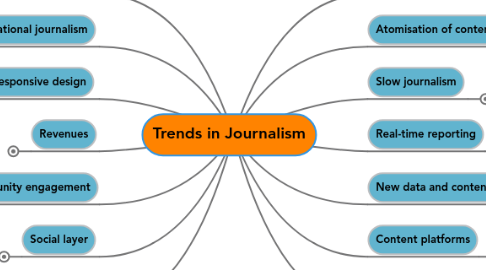Trends in Journalism
da Sebastian Horn

1. Data journalism
1.1. Data visualisations
1.2. (Crowd-) source your own data
1.3. Standard tools and practices
1.4. Data journalism on mobile devices
2. Computational journalism
3. Responsive design
3.1. More devices, more screen sizes
3.2. Single column layout
3.3. Context-sensitive content
3.3.1. Location
3.3.2. Daytime
3.4. Mobile content creation
3.5. Responsive ads
4. Revenues
4.1. Paywall models
4.1.1. Hard paywall
4.1.2. Metered paywall
4.1.3. Premium content
4.1.4. Print/online bundling
4.2. Sponsored content
4.3. Re-bundling of content
4.4. Real-time bidding on ads
4.5. Events and conferences
4.6. Grow globally or locally
4.7. Subsidies from non-journalism business
4.8. Foundation or donor funding
5. Community engagement
5.1. Social Media
5.1.1. Shareable content
5.1.2. Sharing features
5.1.3. Social media monitoring
5.2. Eye-witness reports
5.3. Paragraph annotations
5.4. Cross-platform curation
5.5. Error reporting and fact checking
5.6. Sentiment analysis
6. Social layer
6.1. Personalisation based on history, interests, friends
6.2. Follow feature for stories, authors, topics
7. Video
7.1. Use of smartphones, DSLRs
7.2. Web-first distribution (not TV)
8. New storytelling formats
8.1. Snowfall-like projects
8.2. Listicals
9. Atomisation of content
9.1. Journalism as structured data
9.2. Creating, searching, presenting, consuming this data?
10. Slow journalism
10.1. Long reads
10.2. Re-bundling content into magazines, ebooks
11. Real-time reporting
11.1. Live news reporting and gathering from various sources
11.2. Combine real-time with summaries, context, analysis
12. New data and content sources
12.1. Sensor networks
12.2. Internet of Things
12.3. Big Data
12.4. Drones
12.5. Google Glass
13. Content platforms
13.1. Networks of external contributors
13.2. "Platishers" (Platform + Publisher)
13.3. Content syndication via feeds and APIs
14. The death of the homepage
14.1. Every article as entry point to a site
14.2. Homepage as a moving stream of news items



